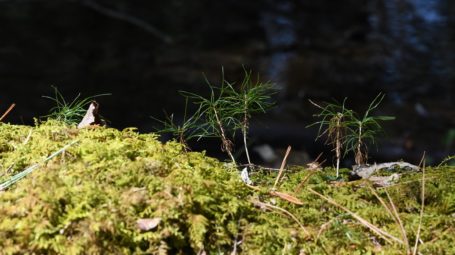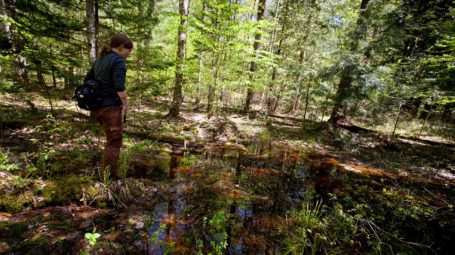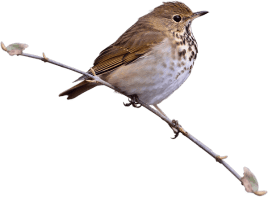Identify Vermont Wildflowers in Winter
5 min read / February 8, 2023 / By Liz Thompson
Our website uses cookies to improve your experience. To learn more about how we use cookies, please review our privacy policy.
Can't find what you're looking for? Please contact us.
With colorful flowers gone, we can more easily see a flower’s structure, and sometimes get a closer look at their amazing fruits and seeds. Let’s explore some of the delicate and beautiful skeletons of summer—wildflowers in their winter garb.
There are dozens of different kinds of goldenrod, and as a group they are among the most easily identified of the wildflowers in winter meadows.
Their flower heads and their distinctive galls are fun things to find and examine more closely.
The ball-like swelling you see here is a common sight in winter meadows. This is a gall, home to the goldenrod gall fly.
The larval stage of this tiny insect lives only in the stems of three species of goldenrod—Canada, tall, and late goldenrod.
The adults lay eggs on the stems of the goldenrod in summer, and as the eggs mature to larvae, they exude a chemical that causes the goldenrod stem to swell and create the ball that you see.
The larvae overwinter in the gall and emerge in spring through a tiny hole.
(Sometimes, the flies are parasitized by wasps, which take over the cozy home and eat the fly larvae!)
Common milkweed is a wildflower we can all recognize in winter by its beautiful pods that slowly shed their tufted seeds starting in late summer. What remains are the empty husks—reminders of the beautiful summer flowers and the butterflies that flitted around them.
Milkweeds are one of the most beneficial plants we can have in our meadows. Several butterfly species feed on the sweet nectar of the milkweed flowers.
Monarch butterflies lay their eggs on milkweed leaves, where the caterpillars develop and morph into adults. These adult butterflies then begin the migration to wintering grounds in Mexico.
Milkweeds are one of the most beneficial plants we can have in our meadows, and they are so easy to grow. (Just stop mowing.)
Poison ivy is a plant we love to hate, but it sure is handsome in the wintertime!
This plant was growing on a high bank along the Winooski River, where it was thriving in the sandy soil and full sun.
There are two species of poison ivy in Vermont. This photo shows western poison ivy in winter, which has shiny berries and grows as a shrub. The other one, common poison ivy, has fuzzy berries and grows as a vine.
Both contain a chemical called urushiol, which can cause a severe rash in humans. All parts of the plant are toxic, even in the dead of winter. So, get close and admire, but don’t touch!
Interestingly, animals can eat the berries without any problem, and many birds do too.
Poison ivy is related to poison oak, a more western plant, and also to poison sumac, which grows in Vermont swamps and is also toxic. Other relatives are staghorn sumac, smooth sumac, and fragrant sumac. Those three sumacs are not toxic.
(Cashews are related to poison ivy, and some people who react especially badly to poison ivy are also allergic to cashews.)
These bold red clusters of fruits are a welcome sight in Vermont’s “stick season.”
American bittersweet is one of two species of bittersweet found in Vermont. The other species, Asiatic bittersweet, is an aggressive, invasive species.
American bittersweet (shown here) has fruits that grow in distinct clusters.
How to tell if it’s the native variety? Both the outer husk and the berry itself are red.
Asiatic bittersweet (shown here) has fruits that grow more loosely along the vine. It also has red berries, but the husks are orange and/or yellow. This invasive plant readily spreads and even take down a tree from its sheer weight.
Asiatic bittersweet is commonly collected for winter wreaths and arrangements. When you are finished with it, be sure not to just toss it out in your woods—you’ll regret it in a few years! Bring it to your local transfer station for proper composting. Learn more about identifying and controlling invasive bittersweet.
Virgin’s bower is a common native Clematis that grows in low, moist places in meadows and along rivers.
In late summer, clouds of fragrant white flowers can be seen even from a distance, on the twining vines that climb over fences and hedges.
As the flowers mature, many fruits develop inside of each, and each tiny, dry fruit develops a long, tufted tail that helps it fly on the wind.
If you are looking for wildflowers in winter, search for these wispy fruits, which remain on the climbing vines. Over time, the winter winds blow the plumed seeds, spreading them to new places.
Other names for virgin’s bower are devil’s darning needles, devil’s hair, love vine, and traveler’s joy.
If you find yourself on a sandy beach in winter, cocklebur is one of the wildflowers you’re sure to notice.
At first you may find it on your shoes or pant legs, but soon you’ll see where those burs came from—a low, stout plant that is reminiscent of burdock and is related to it.
The fruits are designed to stick to mammals (that includes us!) to be moved from place to place.
Cocklebur is a related to sunflower, and both are members of the aster family. But cocklebur doesn’t look much like an aster or a sunflower, even when it is in full bloom. Its flowers are tiny and almost invisible.
But if you open that bur (carefully!), inside you will find two seed-like fruits that look just like sunflower seeds—and there you will see the resemblance.
Winterberry holly is a native shrub that grows commonly in swamps and other low, wet places.
It is a true holly, but unlike the holly we use in winter decorations (a more southern plant), the leaves of winterberry are deciduous, falling off in winter. The bright red berries are then all the more conspicuous.
These berries are a rich source of nutrients for winter birds. Among the birds that enjoy them are eastern bluebird, American robin, thrushes, and cedar waxwings.
Winterberries are cultivated as ornamental shrubs, and some of the cultivated varieties have larger fruits than the native plants, but they are the same species.
Separate male and female flowers occur on separate shrubs, so if you plant them, be sure to include at least one male plant so that the females can be pollinated by bees and other insects.
And if you have bluebirds in your neighborhood, enjoy the bright berries for the short period of time before the bluebirds discover them, because once that happens, they will vanish quickly. Have your binoculars ready to watch the feast!



We generally send two emails per month. You can unsubscribe at any time.